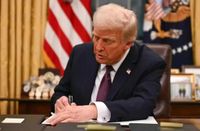The recent announcement by U.S. President Donald Trump regarding sweeping tariffs has sparked significant international tensions, particularly with China. The new tariffs, imposing a staggering 54% rate on Chinese imports, have raised alarms about a potential trade war, with various sectors bracing for disruption. The Trump administration defends these tariffs as necessary measures to protect American industries and address long-standing trade imbalances. However, critics are voicing concerns that these actions could lead to increased consumer prices and broader global economic instability.
In response to Trump's tariffs, which include a 34% charge on Chinese products added to an existing 20%, China has firmly opposed these measures. On April 3, 2025, the Chinese government announced that it would implement "countermeasures to safeguard" its rights and interests. This development has led to speculation about the potential retaliatory actions China might take.
DeepSeek, China's leading AI disrupter, provided insights into the situation, emphasizing a "mutually beneficial strategy" in international trade. When asked whether Trump's tariffs would negatively impact China, DeepSeek highlighted the country's commitment to a cooperative and open global economy. They stated, "No external factors can hinder China's progress," reflecting confidence in China's ability to navigate these challenges. The organization outlined several strategic options available to China in response to U.S. tariffs.
Among the potential retaliatory measures, DeepSeek noted that China could impose targeted tariffs on key U.S. exports, including agricultural products such as soybeans and pork, as well as aircraft, automobiles, and energy products. This strategy aims to exert pressure on politically sensitive U.S. industries, particularly in key electoral states.
Additionally, China has significant control over global supply chains, especially in rare earth metals, which are critical for various technologies, including electronics and defense. By restricting exports of these materials, China could disrupt U.S. manufacturing, a tactic they have employed in past trade disputes.
Non-tariff barriers and regulatory measures could also be part of China's response. This might include stricter inspections on U.S. imports, anti-dumping investigations against U.S. products, and preferential treatment for non-U.S. companies in government procurement. Such measures could complicate U.S. businesses' operations in China and further escalate tensions.
Moreover, China could focus on diversifying its trade partnerships to reduce dependence on the U.S. market. Strengthening trade with regions such as the European Union, ASEAN, Africa, and Latin America through new agreements could help mitigate the impact of U.S. tariffs. The acceleration of the Regional Comprehensive Economic Partnership (RCEP) also aims to deepen economic ties within the Asia-Pacific region.
In terms of financial strategies, allowing the yuan to depreciate could make Chinese exports more competitive in the global market, while potentially dumping U.S. Treasury bonds remains an option, albeit a risky one. Legal challenges at the World Trade Organization (WTO) against U.S. tariffs could also be on the table, as China seeks to rally support from other affected countries to counter U.S. protectionism.
Domestically, China may respond by boosting consumption to offset potential export losses and accelerating its technological independence. Policies like "Made in China 2025" aim to enhance self-sufficiency in critical sectors such as semiconductors.
As the situation unfolds, the international community is watching closely. The European Union has also reacted to Trump's tariff announcements, with President Ursula von der Leyen stating that the bloc will respond in a unified manner. The EU is reportedly finalizing a retaliation package of up to 26 billion euros (approximately $28.5 billion) in tariffs on American products, expected to be announced by mid-April.
This escalating trade conflict could have far-reaching implications, not just for the U.S. and China, but for the global economy as a whole. The interplay of tariffs and retaliatory measures could lead to increased market volatility, affecting businesses and consumers worldwide.
In summary, the imposition of tariffs by the Trump administration has set off a chain reaction, with China and the EU poised to respond robustly. The potential for a trade war raises questions about the future of international trade relations and the global economy.






